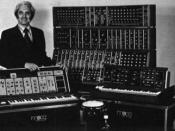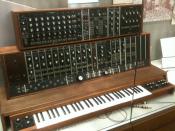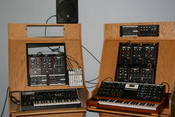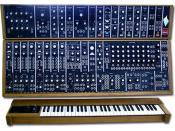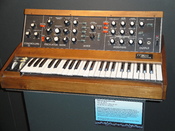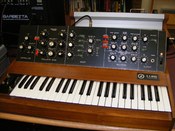May 23, 1934 is a day that any musician should be familiar with. Especially those whom use electronically created sounds in their compositions. Every so often throughout written history a person comes along who is able to jar society and steer it into another direction. In the world of physics that person was Albert Einstein. For African-American civil liberties it was Dr. Martin Luther King Jr. Amelia Earhart became a celebrity after she flew a solo flight across the Atlantic during a period when woman's suffrage began to bring about serious recognition. A lesser known individual by the name of Dr. Robert Arthur Moog initiated a ground breaking change in the field of music forever. Prior to his birth on May 23, 1934, music creation as an art had reached their limit with the acceptance of inharmonic compositions such as Stravinsky's Rite of Spring. Yet, almost theatrically occurring at the right moment, Moog invented the Moog Synthesizer.
With this advent, the music world was handed the ability to create sound electronically. Moog's accomplishments, though some seemed useless and not practical at the time, laid the foundation for a new branch of music creation that many musicians presently take advantage of.
Born in Flushing, New York, Moog studied physics and electrical engineering at Columbia University, and engineering physics at Cornell University. In 1954, while still an undergraduate studying physics at Queens College, New York, by the age of nineteen he formed his own company, the R.A. Moog Company, with the aim of producing a keyboard musical instrument which would replicate the sound of any instrument electronically. Moog's company at first produced several models of the Theremin, an early electronic instrument invented in Russia by Leon Theremin in 1920. Moog's early interest in the Theremin began at the age of fifteen when he obtained "a schematic diagram of the 'original' RCA theremin, and studied it carefully. That was the beginning of my real understanding of what a genius Theremin was." (amazings.com) With a father who had an interest in electronics, and mother with a passion for piano, it seems only natural that he "learned to play the piano as a child, because my mother wanted me to. But what I really wanted to do was fool around with electronics as my father did. When I was 14 I built an electronic instrument, a theremin, from a do-it-yourself magazine article." (newscientist.com) His zeal for the Theremin lead to providing "do-it-yourself" Theremin kits, of which, by the age of nineteen, he sold over one thousand. "'People didn't know what to make of it or what they were going to do with it,' Moog recalls, 'but they knew they wanted to have one.' Some of its first customers were in the TV industry, where the gizmo's chirps and whistles were used for inecartoon noises and other peculiar sounds." (Entertainment Weekly) "In September 1964 he was invited to exhibit his circuits at the Audio Engineering Society Convention. Shortly afterwards in 1964 Moog begin to manufacture electronic music synthesizers." (Obsolete.com) Working with American composer Herbert Deutsch, Moog introduced a circuit which then enabled the advent of his prototype Moog Synthesizer; it first debuted at a convention in 1964. The principle behind Moogs prototype is the use of Voltage-Controlled Electronic Music Modules (the use of controlled generators and controlled filters.) This allows the performer to create his own sounds by connecting modules with electric wires and by turning knobs. "A Moog covers three and a half octaves, 44 notes. You play it one note at a time like a solo instrument; in terms of traditional performance you cannot play chords on it. From 1964 through 1970, the only instruments we made were large modular ones designed for use in studios. These were the instruments on which the Moog records of the late 60s were made. At the same time we began to get a lot of enquiries about smaller instruments from working musicians who wanted to carry it to recording sessions or a gig. We designed the Minimoog in response to that." (newscientist.com) The Moog Synthesizer represented a significant advance over previous electronic synthesizers because of its use of new semiconductor technology. In addition, the new instrument was less expensive to produce. As a result, it was soon in demand all over the world and came to be known simply as the "Moog".
In 1964 Moog began a collaboration with American composer and organist Walter Carlos (later Wendy Carlos,) who released her million-selling record Switched on Bach in 1969. This brought credibility to electronically based music and made the Moog a synonymous name tied with electronic music production. Moog's instruments shortly after made the first leap from the electronic avant garde, into commercial popular music. The Beatles bought one, as did Mick Jagger who bought a hugely expensive modular Moog in 1967.
In 1973, he sold half his Moog trademark to a larger music company, Norlin, taking a job as president of Moog Music. Four years later, fed up with the company's "testosterone-laden corporate atmosphere," (Analog Days) he quit and moved from a suburb in Buffalo to North Carolina, where he spent the next few years building a house with his first wife, Shirleigh, and their four children. The synthesizer fit into the 70's era very well. But in the mid 80's Norlin went under and sold off the Moog trade name. It took 15 years of legal wrangling before Moog would be allowed to sell instruments with his name on them.
In 1970 Moog introduced the compact and portable Minimoog, which soon became a favorite of many performers of jazz and rock music. The Polymoog, which was able to produce chords, appeared in 1976. Other models include the Beginning in 1983 with the establishment of the Musical Instruments Digital Interface (MIDI), a standardized system of computer codes, a new generation of sophisticated and affordable musical synthesizers were produced by various manufacturers. Consequently, Moog synthesizers were used less frequently. Most keyboard-based acts, like Depeche Mode and Thomas Dolby, were going polyphonic digital, and by the 90's synthesizers were considered out dated. "'We bought up all the Moogs nobody wanted,' says Brian Kehew, cofounder of Moog Cookbook, a cover band that helped jump-start the Moog revival in the late '90s with creations like an electronic version of Nirvana's Smells Like Teen Spirit. 'People wanted a band, guitars. Keyboards were seen as dorky.'" (Entertainment Weekly) Moog is portrayed by those who knew him as "a humble man with a great sense of humor." (Analog Days) His accomplishments in the electronic music world have since earned him praise and the title of genius; all of which he replies "I don't see myself as a musician. But rather a craftsman of tools for composers and musicians. I've always enjoyed working with composers." (Analog Days) Synthesizers are now everywhere. They are used in almost every genre of music. Throughout the 60's, 70's, 80's, 90's, and currently, electronically produced music leaves its mark. The harsh industrial sound of the band Nine Inch Nails relies heavily on analog Moog synthesizers. Every artist that uses synthesized sound can trace it back to Moog in one way or another. Dr. Robert A. Moog passed away on August 21, 2005. His name will always go hand in hand with the mention of electronic music. Those truly love electronics and music have him to thank. He provided an upcoming artistic generation of people with something to do.
"At the cluttered desk in his Asheville office, Moog snatches a sheet of paper listing current clients: Nick Rhodes from Duran Duran, Chad Hugo from the Neptunes, Snoop Dogg (or as Moog wrote it, Snoopy Dogg), and Printz Board of the Black Eyed Peas. ('I use the Moog now to thicken my beats, like a special sauce,' says Board.) 'Wanna see something wild?' Moog asks, plucking up a picture sent in by an overeager fan. It shows a half-naked woman with the word 'MOOG' tattooed on her back. 'I just can't...it's baffling to me,' he stammers, shuffling the photo under some other papers. And it's really not even a close second to his biggest turn-on. 'Forty years later,' he says, fiddling again with the Anniversary Edition of the Minimoog Voyager, the room filling with wet electro-kerplunks, 'I still get little goose bumps when I make these sounds.'" (Entertainment Weekly) Works Cited Munnshe. Interview With Robert Moog. 1998. http://www.amazings.com/articles/article0036.html.
19 April 2005 Hamer, Mick. Interview: Electronic maestros. 26 March 2005. http://www.newscientist.com/channel/opinion/mg18524921.400. 19 April 2005 Miller, Nancy. "This Man Rocks..." Entertainment Weekly. 17 September 2004. Pg. 34 Robert Moog And Moog Synthesizers. http://www.obsolete.com/120_years/machines/moog/.
19 April 2005 Pinch, Trevor, and Frank Trocco. Analog Days. Harvard University Press: 2002
